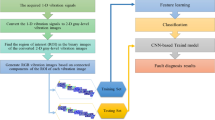Abstract
This paper suggests an image gradient based method that determines the optimal image size for convolutional neural network (CNN)-based diagnosis of fluid-film rotorbearing systems. As distinct patterns improve the diagnosis performance, a criterion is defined to measure the intensity of patterns in an image. The proposed criterion is derived by segmenting an image by the size of the CNN filter and evaluating each segment through the use of image gradient analysis. Vibration signals from a testbed are used to demonstrate the proposed method. First, the signals are transformed into vibration images by using an omnidirectional regeneration technique. Then, vibration images of four different health states are analyzed using the suggested criterion. The analyzed results are compared to the performance of CNN based diagnosis. The results indicate that the proposed criterion can determine the optimal size range of the vibration image that gives the best performance for CNN-based diagnosis.
Similar content being viewed by others
References
J. H. Jung, Investigation on preprocessing and transformation of vibration signals for deep learning based diagnosis of rotating machinery, Ph.D. Thesis, Seoul National University (2019).
R. Zhao et al., Deep learning and its applications to machine health monitoring, Mech. Syst. Signal Process, 115 (2019) 213–237.
Z. Gao, C. Cecati and S. X. Ding, A survey of fault diagnosis and fault-tolerant techniques—Part I: Fault diagnosis with model-based and signal-based approaches, IEEE Trans. Ind. Electron., 62 (6) (2015) 3757–3767.
X. Guo, L. Chen and C. Shen, Hierarchical adaptive deep convolution neural network and its application to bearing fault diagnosis, Measurement, 93 (2016) 490–502.
O. Janssens et al., Convolutional neural network based fault detection for rotating machinery, J. Sound Vib., 377 (2016) 331–345.
Z. Chen, C. Li and R.-V. Sanchez, Gearbox fault identification and classification with convolutional neural networks, Shock Vib., 2015 (2015).
T. Ince et al., Real-time motor fault detection by 1-d convolutional neural networks, IEEE Trans. Ind. Electron., 63 (2016) 7067–7075.
C. Lu, Z. Wang and B. Zhou, Intelligent fault diagnosis of rolling bearing using hierarchical convolutional network based health state classification, Adv. Eng. Informatics, 32 (2017) 139–151.
R. Liu et al., Dislocated time series convolutional neural architecture: An intelligent fault diagnosis approach for electric machine, IEEE Trans. Ind. Informatics (2016).
K. B. Lee, S. Cheon and C. O. Kim, A convolutional neural network for fault classification and diagnosis in semiconductor manufacturing processes, IEEE Trans. Semicond. Manuf., 30 (2017) 135–142.
Y. Xie and T. Zhang, Fault diagnosis for rotating machinery based on convolutional neural network and empirical mode decomposition, Shock Vib., 2017 (2017).
Y. LeCun et al., Gradient-based learning applied to document recognition, Proc. IEEE, 86 (11) (1998) 2278–2324.
J. H. Jung et al., Omnidirectional regeneration (ODR) of proximity sensor signals for robust diagnosis of journal bearing systems, Mech. Syst. Signal Process., 90 (2017) 189–207.
H. Oh et al., Scalable and unsupervised feature engineering using vibration-imaging and deep learning for rotor system diagnosis, IEEE Trans. Ind. Electron., 65 (2018) 3539–3549.
V. Nair and G. E. Hinton, Rectified linear units improve restricted boltzmann machines, Proc. 27th Int. Conf. Mach. Learn. (2010) 807–814.
Y. LeCun, Y. Bengio and G. Hinton, Deep learning, Nature, 521 (2015) 436.
A. Krizhevsky, I. Sutskever and G. E. Hinton, Imagenet classification with deep convolutional neural networks, Adv. Neural Inf. Process. Syst. (2012) 1097–1105.
A. Karpathy et al., Large-scale video classification with convolutional neural networks, Proc. IEEE Conf. Comput. Vis. Pattern Recognit. (2014) 1725–1732.
H. Li et al., A convolutional neural network cascade for face detection, Proc. IEEE Conf. Comput. Vis. Pattern Recognit. (2015) 5325–5334.
S. Ji et al., 3D convolutional neural networks for human action recognition, IEEE Trans. Pattern Anal. Mach. Intell., 35 (2013) 221–231.
J. R. Dim and T. Takamura, Alternative approach for satellite cloud classification: Edge gradient application, Adv. Meteorol., 2013 (2013).
J. M. S. Prewitt, Object enhancement and extraction, Pict. Process. Psychopictorics, 10 (1) (1970) 15–19.
L. G. Roberts, Machine perception of three-dimensional solids, Ph.D. Thesis, MIT (1963).
N. Dalal and B. Triggs, Histograms of oriented gradients for human detection, International Conference on Computer Vision & Pattern Recognition (CVPR '05) (2005).
Acknowledgments
This research was supported by National Research Foundation (NRF) (Project No. NRF-2018M2A8A4023312), Korea Institute of Machinery and Materials (KIMM), and the 2017 Open R&D Program of Korea Electric Power Corporation (KEPCO) under Grant R17tH02.
Author information
Authors and Affiliations
Corresponding author
Additional information
Recommended by Editor No-cheol Park
Byeng Dong Youn received the B.S. degree in Mechanical Engineering from Inha University, Incheon, South Korea, in 1996, the M.S. degree in Mechanical Engineering from Korea Advanced Institute of Science & Technology, Daejeon, South Korea, in 1998, and the Ph.D. degree in Mechanical Engineering from the University of Iowa, Iowa City, IA, USA, in 2001. He is a Professor with the Department of Mechanical and Aerospace Engineering, Seoul National University, Seoul, South Korea. Dr. Youn was the recipient of ASME IDETC Best Paper Awards (2001 and 2008), the ISSMO/Springer Prize for a Young Scientist (2005), the IEEE PHM Competition Winner (2014), the PHM Society Data Challenge Competition Winner (2014, 2015, 2017, 2019), etc.
Rights and permissions
About this article
Cite this article
Jeon, B.C., Jung, J.H., Kim, M. et al. Optimal vibration image size determination for convolutional neural network based fluid-film rotor-bearing system diagnosis. J Mech Sci Technol 34, 1467–1474 (2020). https://doi.org/10.1007/s12206-020-0308-z
Received:
Revised:
Accepted:
Published:
Issue Date:
DOI: https://doi.org/10.1007/s12206-020-0308-z




